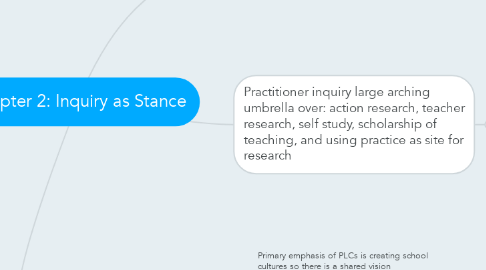Chapter 2: Inquiry as Stance
by Colleen Lorenz


1. Shared characteristics of PLCS
1.1. Primary emphasis of PLCs is creating school cultures so there is a shared vision
1.2. Both have inquiry, data, communities, learning from data, cultures of schools, and equity
1.3. Practitioner inquiry: social movements, data of practice, multiple contexts for change
1.4. PLCS: school effects, best local practice, assessment data, school is unit of change
2. Inquiry communities structured to foster deep intellectual discourse
3. Practitioner inquiry large arching umbrella over: action research, teacher research, self study, scholarship of teaching, and using practice as site for research
3.1. Common characteristics
3.1.1. Practitioner as researcher
3.1.2. Links of knowledge, knowers, and knowing
3.1.3. Professional context as site for study
3.1.4. Community and collaboration
3.1.5. Blurred boundaries between inquiry and practice
3.1.6. New conceptions of validity and generalizability
3.1.7. Data collection and analysis
3.1.8. Publicity, public knowledge, critique
3.2. Critiques of practitioner inquiry
3.2.1. Not "real research"
3.2.2. What kind of knowledge is generated with practitioners do research in their own context
3.2.3. Ethics critique: dual roles
